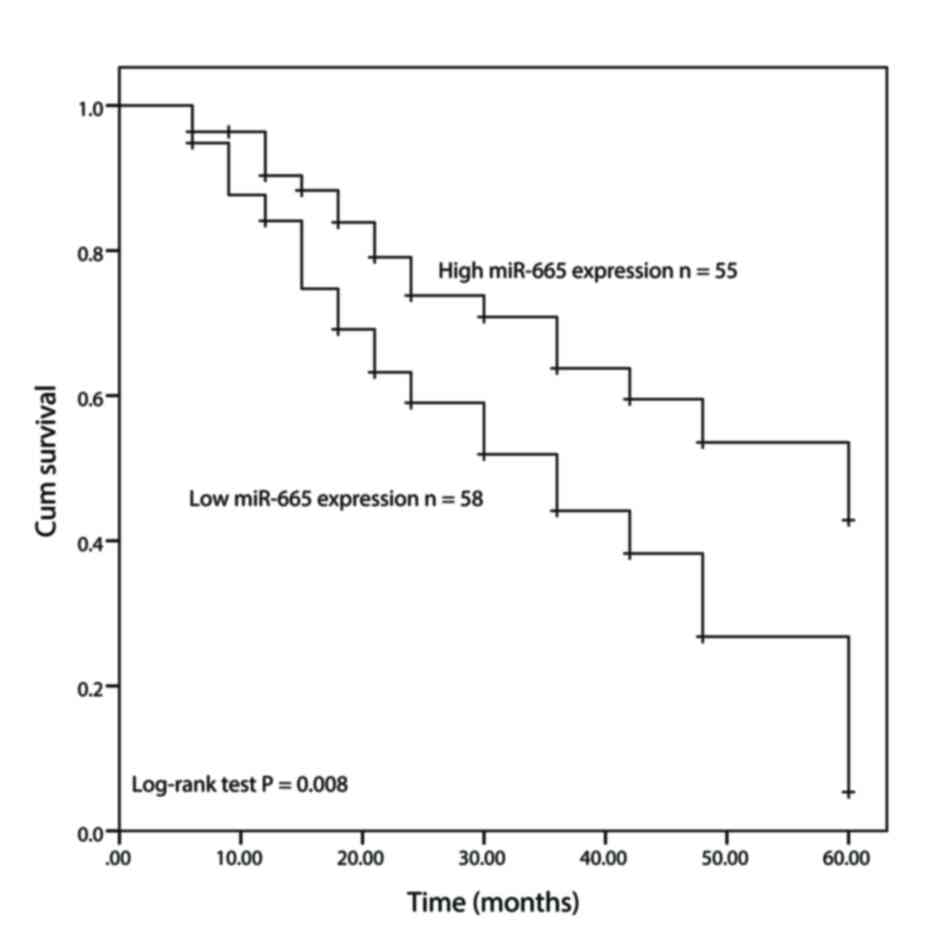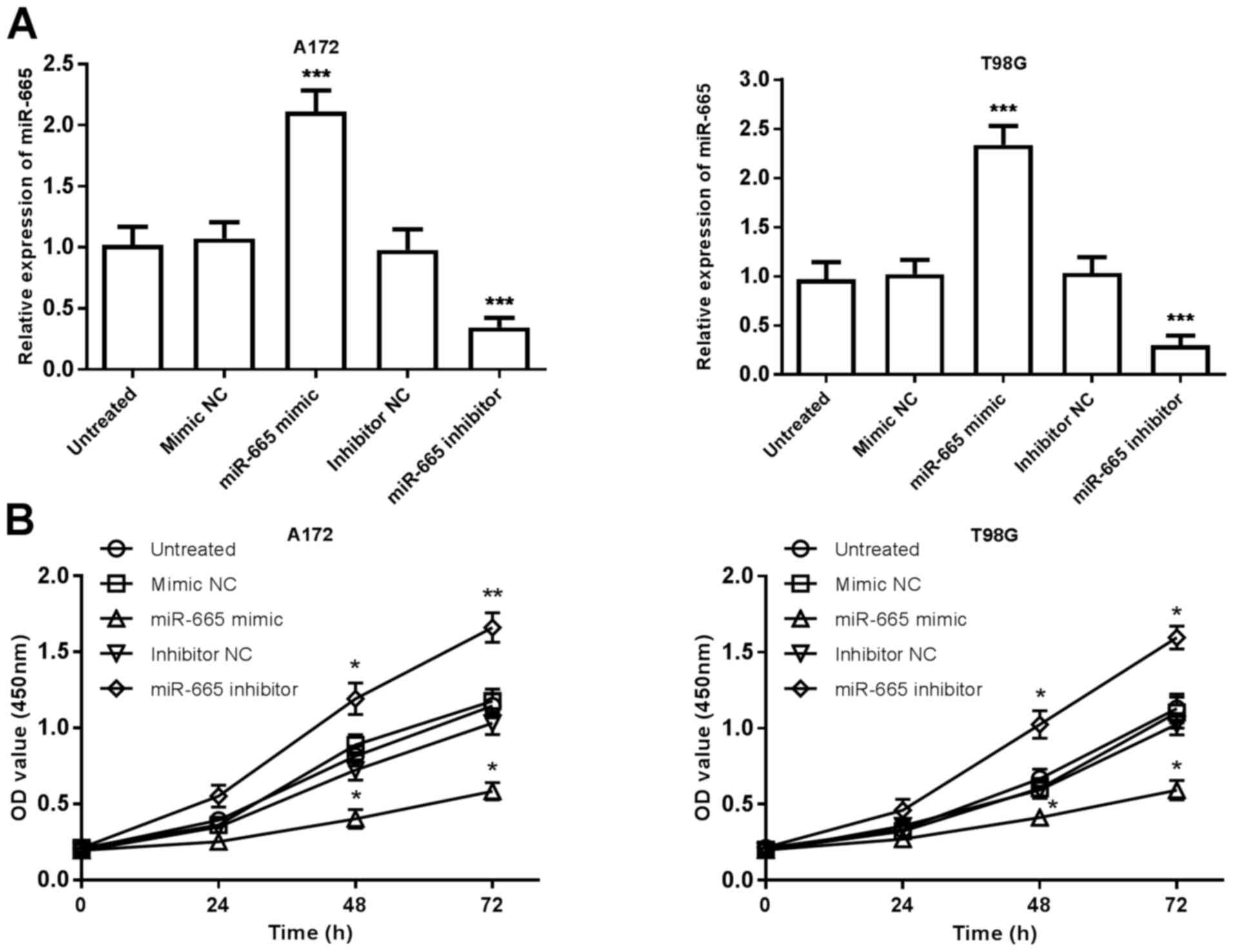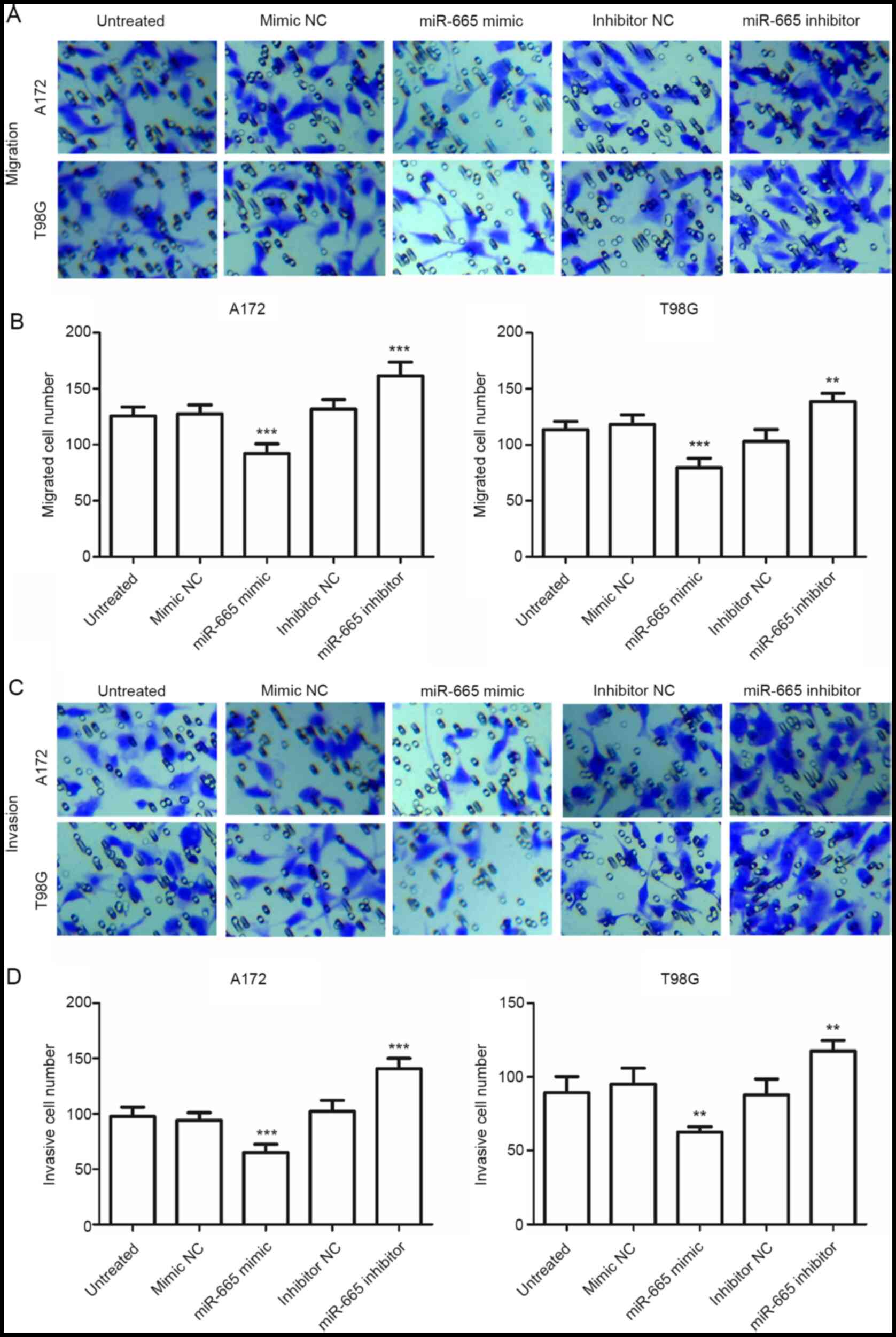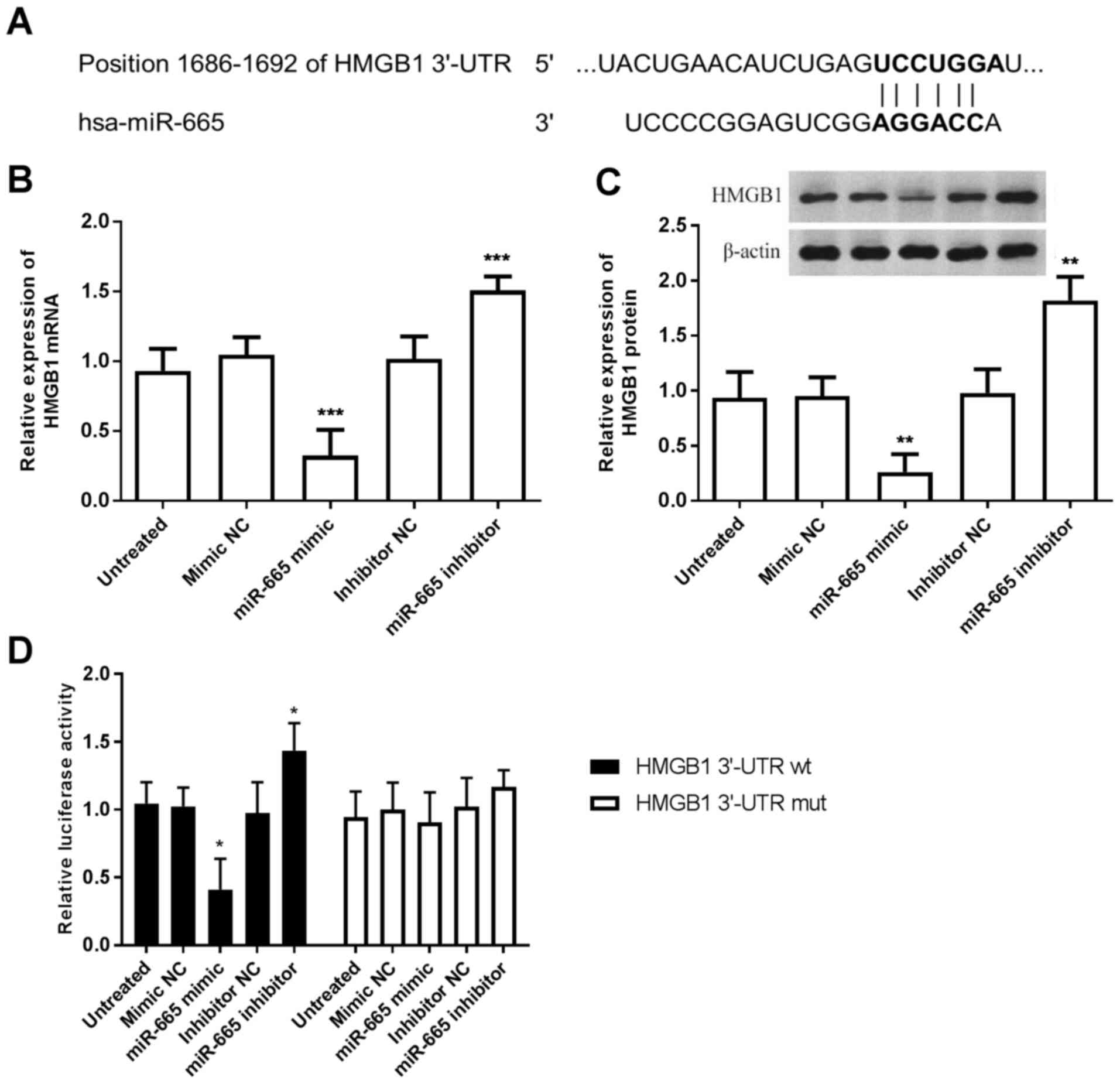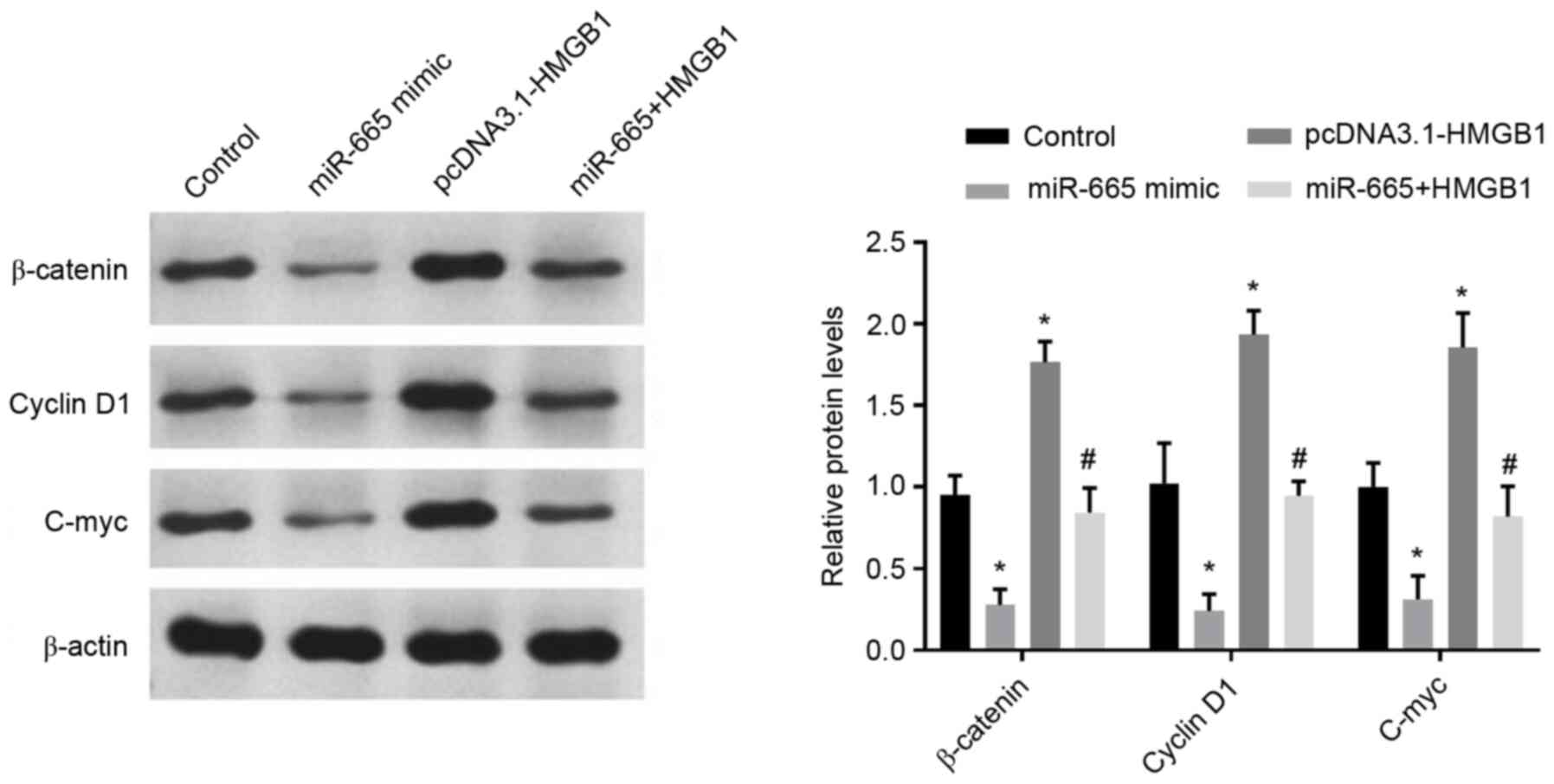|
1
|
Louis DN, Perry A, Reifenberger G, von
Deimling A, Figarella-Branger D, Cavenee WK, Ohgaki H, Wiestler OD,
Kleihues P and Ellison DW: The 2016 World Health Organization
Classification of tumors of the central nervous system: A summary.
Acta Neuropathol. 131:803–820. 2016. View Article : Google Scholar : PubMed/NCBI
|
|
2
|
Hummel S, Kohlmann W, Kollmeyer TM,
Jenkins R, Sonnen J, Palmer CA, Colman H, Abbott D, Cannon-Albright
L and Cohen AL: The contribution of the rs55705857 G allele to
familial cancer risk as estimated in the Utah population database.
BMC Cancer. 19:1902019. View Article : Google Scholar : PubMed/NCBI
|
|
3
|
Iser IC, Pereira MB, Lenz G and Wink MR:
The epithelial-to-mesenchymal transition-like process in
glioblastoma: An updated systematic review and in silico
investigation. Med Res Rev. 37:271–313. 2017. View Article : Google Scholar : PubMed/NCBI
|
|
4
|
Jiang T, Mao Y, Ma W, Mao Q, You Y, Yang
X, Jiang C, Kang C, Li X, Chen L, et al: CGCG clinical practice
guidelines for the management of adult diffuse gliomas. Cancer
Lett. 375:263–273. 2016. View Article : Google Scholar : PubMed/NCBI
|
|
5
|
Champ CE, Palmer JD, Volek JS,
Werner-Wasik M, Andrews DW, Evans JJ, Glass J, Kim L and Shi W:
Targeting metabolism with a ketogenic diet during the treatment of
glioblastoma multiforme. J Neurooncol. 117:125–131. 2014.
View Article : Google Scholar : PubMed/NCBI
|
|
6
|
Linz U: Commentary on Effects of
radiotherapy with concomitant and adjuvant temozolomide versus
radiotherapy alone on survival in glioblastoma in a randomised
phase III study: 5-year analysis of the EORTC-NCIC trial (Lancet
Oncol. 2009;10:459-466). Cancer. 116:1844–1846. 2010. View Article : Google Scholar : PubMed/NCBI
|
|
7
|
Arvold ND and Reardon DA: Treatment
options and outcomes for glioblastoma in the elderly patient. Clin
Interv Aging. 9:357–367. 2014.PubMed/NCBI
|
|
8
|
Hammond SM: An overview of microRNAs. Adv
Drug Deliv Rev. 87:3–14. 2015. View Article : Google Scholar : PubMed/NCBI
|
|
9
|
Kim DY and Sung JH: Regulatory role of
microRNAs in the proliferation and differentiation of
adipose-derived stem cells. Histol Histopathol. 32:1–10.
2017.PubMed/NCBI
|
|
10
|
Mahmoudian-Sani MR, Jalali A, Jamshidi M,
Moridi H, Alghasi A, Shojaeian A and Mobini GR: Long non-coding
RNAs in thyroid cancer: Implications for pathogenesis, diagnosis,
and therapy. Oncol Res Treat. 42:136–142. 2019. View Article : Google Scholar : PubMed/NCBI
|
|
11
|
Rivera-Barahona A, Pérez B, Richard E and
Desviat LR: Role of miRNAs in human disease and inborn errors of
metabolism. J Inherit Metab Dis. 40:471–480. 2017. View Article : Google Scholar : PubMed/NCBI
|
|
12
|
Paliouras AR, Monteverde T and Garofalo M:
Oncogene-induced regulation of microRNA expression: Implications
for cancer initiation, progression and therapy. Cancer Lett.
421:152–160. 2018. View Article : Google Scholar : PubMed/NCBI
|
|
13
|
Wu Y, Song Y, Xiong Y, Wang X, Xu K, Han
B, Bai Y, Li L, Zhang Y and Zhou L: MicroRNA-21 (Mir-21) Promotes
cell growth and invasion by repressing tumor suppressor PTEN in
colorectal cancer. Cell Physiol Biochem. 43:945–958. 2017.
View Article : Google Scholar : PubMed/NCBI
|
|
14
|
Liu DZ, Zhao H, Zou QG and Ma QJ: MiR-338
suppresses cell proliferation and invasion by targeting CTBP2 in
glioma. Cancer Biomark. 20:289–297. 2017. View Article : Google Scholar : PubMed/NCBI
|
|
15
|
Svoronos AA, Engelman DM and Slack FJ:
OncomiR or tumor suppressor? The duplicity of MicroRNAs in cancer.
Cancer Res. 76:3666–3670. 2016. View Article : Google Scholar : PubMed/NCBI
|
|
16
|
Möhnle P, Schütz SV, Schmidt M, Hinske C,
Hübner M, Heyn J, Beiras-Fernandez A and Kreth S: MicroRNA-665 is
involved in the regulation of the expression of the
cardioprotective cannabinoid receptor CB2 in patients with severe
heart failure. Biochem Biophys Res Commun. 451:516–521. 2014.
View Article : Google Scholar : PubMed/NCBI
|
|
17
|
Tan H, Zhao L, Song R, Liu Y and Wang L:
microRNA-665 promotes the proliferation and matrix degradation of
nucleus pulposus through targeting GDF5 in intervertebral disc
degeneration. J Cell Biochem. 119:7218–7225. 2018. View Article : Google Scholar : PubMed/NCBI
|
|
18
|
Liu NW, Huang X, Liu S and Lu Y: EXT1,
regulated by MiR-665, promotes cell apoptosis via ERK1/2 signaling
pathway in acute lymphoblastic leukemia. Med Sci Monit.
25:6491–6503. 2019. View Article : Google Scholar : PubMed/NCBI
|
|
19
|
Ye X, Wei W, Zhang Z, He C, Yang R, Zhang
J, Wu Z, Huang Q and Jiang Q: Identification of microRNAs
associated with glioma diagnosis and prognosis. Oncotarget.
8:26394–26403. 2017. View Article : Google Scholar : PubMed/NCBI
|
|
20
|
Tesarova P, Kalousova M, Zima T and Tesar
V: HMGB1, S100 proteins and other RAGE ligands in cancer-markers,
mediators and putative therapeutic targets. Biomed Pap Med Fac Univ
Palacky Olomouc Czech Repub. 160:1–10. 2016. View Article : Google Scholar : PubMed/NCBI
|
|
21
|
Wang Y, Jiang Z, Yan J and Ying S: HMGB1
as a potential biomarker and therapeutic target for malignant
mesothelioma. Dis Markers. 2019:41831572019.PubMed/NCBI
|
|
22
|
Wu T, Zhang W, Yang G, Li H, Chen Q, Song
R and Zhao L: HMGB1 overexpression as a prognostic factor for
survival in cancer: A meta-analysis and systematic review. Dis
Markers. 7:50417–50427. 2016.
|
|
23
|
Zhao Y, Yi J, Tao L, Huang G, Chu X, Song
H and Chen L: Wnt signaling induces radioresistance through
upregulating HMGB1 in esophageal squamous cell carcinoma. Cell
Death Dis. 9:4332018. View Article : Google Scholar : PubMed/NCBI
|
|
24
|
Reed KR, Song F, Young MA, Hassan N,
Antoine DJ, Gemici NB, Clarke AR and Jenkins JR: Secreted HMGB1
from Wnt activated intestinal cells is required to maintain a crypt
progenitor phenotype. Oncotarget. 7:51665–51673. 2016. View Article : Google Scholar : PubMed/NCBI
|
|
25
|
Nagane M, Kobayashi K, Ohnishi A, Shimizu
S and Shiokawa Y: Prognostic significance of O6-methylguanine-DNA
methyltransferase protein expression in patients with recurrent
glioblastoma treated with temozolomide. Jpn J Clin Oncol.
37:897–906. 2007. View Article : Google Scholar : PubMed/NCBI
|
|
26
|
Li C, Zou H, Wang Z, Tang X, Fan X, Zhang
K, Liu J and Li Z: REST, not REST4, is a risk factor associated
with radiotherapy plus chemotherapy efficacy in glioma. Drug Des
Devel Ther. 12:1363–1371. 2018. View Article : Google Scholar : PubMed/NCBI
|
|
27
|
Livak KJ and Schmittgen TD: Analysis of
relative gene expression data using real-time quantitative PCR and
the 2(-Delta Delta C(T)) method. Methods. 25:402–408. 2001.
View Article : Google Scholar : PubMed/NCBI
|
|
28
|
Wang S, Du S, Lv Y, Zhang F and Wang W:
MicroRNA-665 inhibits the oncogenicity of retinoblastoma by
directly targeting high-mobility group box 1 and inactivating the
Wnt/β-catenin pathway. Cancer Manag Res. 11:3111–3123. 2019.
View Article : Google Scholar : PubMed/NCBI
|
|
29
|
Zhang H, Li X, Meng W, Zhang L, Zhu X, Bai
Z, Yan J and Zhou W: Overexpression of p16ink4a regulates the
Wnt/beta-catenin signaling pathway in pancreatic cancer cells. Mol
Med Rep. 17:2614–2618. 2018.PubMed/NCBI
|
|
30
|
Chen W, Zheng R, Baade PD, Zhang S, Zeng
H, Bray F, Jemal A, Yu XQ and He J: Cancer statistics in China,
2015. CA Cancer J Clin. 66:115–132. 2016. View Article : Google Scholar : PubMed/NCBI
|
|
31
|
Dehghan F, Boozarpour S, Torabizadeh Z and
Alijanpour S: miR-21: A promising biomarker for the early detection
of colon cancer. Onco Targets Ther. 12:5601–5607. 2019. View Article : Google Scholar : PubMed/NCBI
|
|
32
|
Ning S, Liu H, Gao B, Wei W, Yang A, Li J
and Zhang L: miR-155, miR-96 and miR-99a as potential diagnostic
and prognostic tools for the clinical management of hepatocellular
carcinoma. Oncol Lett. 18:3381–3387. 2019.PubMed/NCBI
|
|
33
|
Chen Y, Li ZH, Liu X, Liu GX, Yang HM and
Wu PF: Reduced expression of miR-3653 in glioma and its
correlations with clinical progression and patient survival. Eur
Rev Med Pharmacol Sci. 23:6596–6601. 2019.PubMed/NCBI
|
|
34
|
Xu G, Fang P, Chen K, Xu Q, Song Z and
Ouyang Z: MicroRNA-362-3p Targets PAX3 to Inhibit the Development
of Glioma through Mediating Wnt/beta-Catenin Pathway.
Neuroimmunomodulation. 26:119–128. 2019. View Article : Google Scholar : PubMed/NCBI
|
|
35
|
Wu M, Li X, Liu Q, Xie Y, Yuan J and
Wanggou S: miR-526b-3p serves as a prognostic factor and regulates
the proliferation, invasion, and migration of glioma through
targeting WEE1. Cancer Manag Res. 11:3099–3110. 2019. View Article : Google Scholar : PubMed/NCBI
|
|
36
|
Sun X, Cui S, Fu X, Liu C, Wang Z and Liu
Y: MicroRNA-146-5p promotes proliferation, migration and invasion
in lung cancer cells by targeting claudin-12. Cancer Biomark.
25:89–99. 2019. View Article : Google Scholar : PubMed/NCBI
|
|
37
|
Chen S, Shi F, Zhang W, Zhou Y and Huang
J: miR-744-5p inhibits non-small Cell lung cancer proliferation and
invasion by directly targeting PAX2. Technol Cancer Res Treat.
18:15330338198769132019. View Article : Google Scholar : PubMed/NCBI
|
|
38
|
Wang J, Liu H, Zheng K, Zhang S and Dong
W: MicroRNA-6852 suppresses glioma A172 cell proliferation and
invasion by targeting LEF1. Exp Ther Med. 18:1877–1883.
2019.PubMed/NCBI
|
|
39
|
Zuo J, Yu H, Xie P, Liu W, Wang K and Ni
H: miR-454-3p exerts tumor-suppressive functions by down-regulation
of NFATc2 in glioblastoma. Gene. 710:233–239. 2019. View Article : Google Scholar : PubMed/NCBI
|
|
40
|
Zhao XG, Hu JY, Tang J, Yi W, Zhang MY,
Deng R, Mai SJ, Weng NQ, Wang RQ, Liu J, et al: miR-665 expression
predicts poor survival and promotes tumor metastasis by targeting
NR4A3 in breast cancer. Cell Death Dis. 10:4792019. View Article : Google Scholar : PubMed/NCBI
|
|
41
|
Hu Y, Yang C, Yang S, Cheng F, Rao J and
Wang X: miR-665 promotes hepatocellular carcinoma cell migration,
invasion, and proliferation by decreasing Hippo signaling through
targeting PTPRB. Cell Death Dis. 9:9542018. View Article : Google Scholar : PubMed/NCBI
|
|
42
|
Cao L, Jin H, Zheng Y, Mao Y, Fu Z, Li X
and Dong L: DANCR-mediated microRNA-665 regulates proliferation and
metastasis of cervical cancer through the ERK/SMAD pathway. Cancer
Sci. 110:913–925. 2019. View Article : Google Scholar : PubMed/NCBI
|
|
43
|
Liu J, Jiang Y, Wan Y, Zhou S, Thapa S and
Cheng W: MicroRNA665 suppresses the growth and migration of ovarian
cancer cells by targeting HOXA10. Mol Med Rep. 18:2661–2668.
2018.PubMed/NCBI
|
|
44
|
Ma Y, Kang S, Wu X, Han B, Jin Z and Guo
Z: Up-regulated HMGB1 in the pleural effusion of non-small cell
lung cancer (NSCLC) patients reduces the chemosensitivity of NSCLC
cells. Tumori. 104:338–343. 2018. View Article : Google Scholar : PubMed/NCBI
|
|
45
|
Li Y and Qin C: MiR-1179 inhibits the
proliferation of gastric cancer cells by targeting HMGB1. Hum Cell.
32:352–359. 2019. View Article : Google Scholar : PubMed/NCBI
|
|
46
|
Zhang J, Zhang R, Lu WW, Zhu JS, Xia LQ,
Lu YM and Chen NW: Clinical significance of hmgb1 expression in
human gastric cancer. Int J Immunopathol Pharmacol. 27:543–551.
2014. View Article : Google Scholar : PubMed/NCBI
|
|
47
|
Angelopoulou E, Piperi C, Adamopoulos C
and Papavassiliou AG: Pivotal role of high-mobility group box 1
(HMGB1) signaling pathways in glioma development and progression. J
Mol Med (Berl). 94:867–874. 2016. View Article : Google Scholar : PubMed/NCBI
|
|
48
|
Zhang J, Liu C and Hou R: Knockdown of
HMGB1 improves apoptosis and suppresses proliferation and invasion
of glioma cells. Chin J Cancer Res. 26:658–668. 2014.PubMed/NCBI
|
















